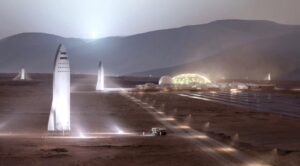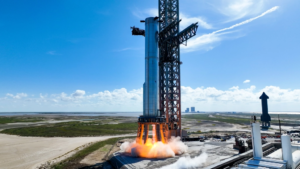
What Happened To SpaceX’s Dual Drone Ship Booster Landing?
SpaceX landing Falcon 9 boosters on drone ships has become quite common but something we haven’t seen much of for Falcon Heavy. In the last 6 missions stretching over the course of more than one year, the heavy lift rocket has expended its center core each time. As for the side boosters, in each of those missions they either were expended as well or made their way back to land.
For these launches, whether or not the core and side boosters are expended and even the difference between landing at sea or land, all effects the performance of the vehicle. Interestingly, not long ago we got hints that the company was going to attempt a simultaneous side booster landing on drone ships. Here I will go more in-depth into that possible mission, the benefits it provides, the importance of drone ships, and more.
Two Boosters Two Drone Ships

In a regular scenario, SpaceX offers three options, depending on launch requirements: landing on land, landing at sea, or expending the first stage, in order of increased performance and cost. Any Falcon flights launched into geostationary orbit or exceeding escape velocity require landing at sea, or expending the first stage. The less propellant needed for landing means the more used to propel the payload to its destination. This is why returning to land is the most costly as it includes a heft boost back burn and eventual landing burn. Drone ships on the other hand while still somewhat minimizing performance, are much further downrange and limit the amount of propellant needed.
These rules apply to both the Falcon 9 and the Falcon Heavy. The Falcon Heavy however is quite unique since its has three boosters meaning two different options for landing. Even though landing two booster at the same time at sea sounds very ambitious, the company has considered it.
In the middle of last year, a Federal Communications Commission (FCC) permit was filed. Within this permit, it was quoted saying, “This STA is necessary to authorize launch vehicle communications and two experimental first-stage droneship recovery operations of the side boosters for SpaceX Falcon Heavy Mission 1468, launching from Complex 39a, Kennedy Space Center. Application includes three sub-orbital first stage boosters, and an orbital second stage. Trajectory data will be provided directly to NTIA, USAF, and NASA. All downrange Earth stations are receive-only. All operations are pre-coordinated with the Range.”
The permit also stated, “Launch vehicle communications for mission launching from LC-39A Kennedy Space Center and the droneship recovery of two side core boosters. Center core is expendable with a water landing.” These various quotes from the permit hinted at a few important things about the mission. First and most obvious was that the launch looked like it was going to attempt a simultaneous booster landing of the two side boosters. It also mentioned that the center core was going to be expended and would not attempt to land. This would have been a compromise and slightly less performance than expending all three boosters.
Unfortunately, the mission eventually came around and rather than two drone ship landings, the center core was expended and the two sides boosters returned to land. It’s possible that as the mission approached, it was determined that slightly less performance was needed to launch the satellite. Interestingly, the mission was sending the Jupiter 3 payload, which was the Heaviest commercial geostationary satellite ever, weighing 9,200 kg (20,300 lb) at launch. SpaceX knowing the significant payload needs for this launch may have wanted a backup option just in case and the possibility of landing both boosters if they couldn’t return to land.
It’s also important to point out that despite SpaceX’s experience, two drone ship landings at the same time would not be easy. While SpaceX has an impressive history with Falcon 9, with the Falcon Heavy, they have never actually successfully landed a center core on the droneship. On the second flight, the center core managed to land but subsequently fell over and was destroyed. Both the first and third missions ended with a bang after the center core impacted the water for various reasons. Since then, the center core has always just been expended. That being said, those failed center core landing attempts happened back in 2019. In the time since then, SpaceX has landed a ton of Falcon 9 boosters on drone ships and gained a lot of experience. Even though there currently isn’t any known public plan for a simultaneous booster landing at sea, it could end up happening in the future.
Drone Ship Necessity

At the core of a dual landing and even consistent SpaceX operations are the drone ships they operate. In total, SpaceX has three operational drone ships: Just Read the Instructions (II) (JRTI) and A Shortfall of Gravitas (ASOG), operating in the Atlantic for launches from Kennedy Space Center and Cape Canaveral Space Force Station, there also is Of Course I Still Love You (OCISLY), operating in the Pacific for supporting missions from Vandenberg Space Force Base.
Over the past few years as SpaceX has increased the launch cadence of Falcon Heavy and mainly Falcon 9, the number of drone ship landings has also gone up. In 2021 there were 29 drone ship landings, then 48 in 2022, and 78 last year. Already this year we have seen 8 with a lot more planned in the future. The company is hoping to launch around 12 times a month or 144 times in total, a new record for cadence. While exciting, it also puts a lot of pressure on the existing infrastructure.
On average, it takes about a week for the drone ships to land a booster at sea, return to land, drop off the booster, and return to position for another launch. With only three drone ships this conflicts a bit with the launch frequency that SpaceX will attempt to meet. This being said, SpaceX doesn’t need to land boosters on drone ships. In order to meet this frequency goal, we will likely see more Falcon boosters return to the launch site for a landing on the ground. A mix of these landing profiles with the drone ships could support a launch every 2.5 days.
Landing Zone 1 and Landing Zone 2, also known as LZ-1 and LZ-2 respectively, are landing facilities on Cape Canaveral Space Force Station for recovering components of SpaceX’s reusable launch vehicles. Landing Zone 1 is the most commonly used out of the two for occasional Falcon 9 launches. LZ-2 is usually only used when LZ-1 is occupied or during a Falcon Heavy launch where two boosters land at the same time.
In addition, last year in a statement, SLD 45 clarified that “as part of the SLD 45 allocation strategy, Phantom and Vaya Space will be the only users of SLC-13 once the real property agreement is executed.” In other words, SpaceX appears to be ending its use of Landing Zones 1 and 2 in the not too distant future. In an official document, it’s quoted saying, “Through the LPAS, the U.S. Space Force and SLD 45 have selected four companies for allocation of launch property at Space Launch Complex (SLC) 15 to ABL Space, SLC 14 to Stoke Space, and SLC 13 to Phantom Space and Vaya Space.” This document and statement were released on March 7th 2023.
Originally, LZ-1 and LZ-2 were built on land leased in February 2015, on the site of the former Cape Canaveral Launch Complex 13. SpaceX built Landing Zone 2 at the facility to have a second landing pad, allowing two Falcon Heavy boosters to land simultaneously. The previous site was replaced by two circular landing pads 282 feet (86 m) in diameter and marked with a stylized X from the SpaceX company logo.
By now Falcon 9 landings have become extremely reliable and consistent which could give the company confidence to land them closer to valuable infrastructure. Also, this could be considered a stepping stone for landings prior to work on Starship landing operations at LC-39A.
Either way, SpaceX plans to keep launching both Falcon 9 and Falcon Heavy. Looking further into the future, there are some very important missions using the Falcon Heavy. For example, while delays are possible, in 2025 it will launch both the PPE and HALO Gateway modules. The Power and Propulsion Element and Habitation and Logistics Outpost are foundational elements of the Gateway. NASA says, “As the first long-term orbiting outpost around the Moon, the Gateway is critical to supporting sustainable astronauts missions under the agency’s Artemis program.
In another quote they say, “After integration on Earth, the PPE and HALO are targeted to launch together no earlier than May 2024 on a Falcon Heavy rocket from Launch Complex 39A at NASA’s Kennedy Space Center in Florida. The total cost to NASA is approximately $331.8 million, including the launch service and other mission-related costs” they said. The launch date has changed since then but the plan is still the same. The original plan was to launch them separately but they decided to just send them together on one vehicle that could do the job. This led to the selection of Falcon Heavy and preparation for the mission. Besides the future launches that I’ve listed, there are another 10-plus missions scheduled for Falcon Heavy between now and 2029. A handful of opportunities for more landing configurations and variations as SpaceX and its plans develop over time.
Conclusion
Last year it looked like we were going to see a Falcon Heavy attempt a dual side booster drone ship landing. Although it didn’t happen, SpaceX is increasing the launch cadence of both vehicles and we can expect many landings in the future. We will have to wait and see how it progresses and the impact it has on the space industry.



